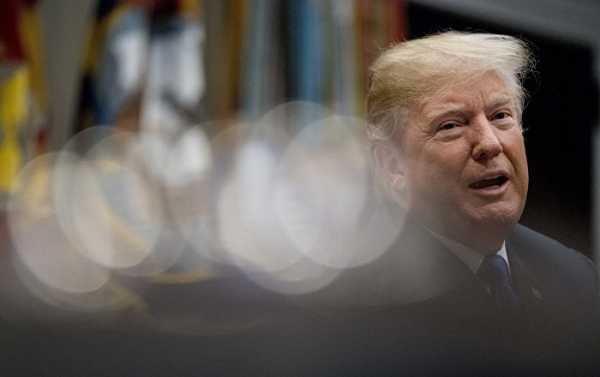
A new round of fiscal stimulus is currently in the works at the White House, according to US President Donald Trump, and some economists see this as part of the administration’s effort to push GDP growth above 4 percent on a sustained annual basis.
Kristian Rouz — US President Donald Trump is floating the idea of a 10-percent tax cut for middle-income Americans, which could arrive as part of the long-anticipated ‘tax cuts 2.0′ fiscal package. Although Trump’s announcement came as news to Congress, the proposed move is seen as a countermeasure designed to offset the negative effects that rising borrowing costs are having on US consumers.
The US President touted the tax cut for America’s middle class on Monday. Economists see the proposed move as bolstering consumer confidence, purchasing power of American households, and, ultimately, pushing GDP growth rate even higher.
“We’re putting in a resolution sometime in the next week or week-and-a-half, two weeks,” Trump said. “We’re giving a middle-income tax reduction of about 10 percent. We’re doing it now for middle-income people.”
Trump’s announcement repeats a promise he made during Saturday’s campaign rally in Nevada, where the US President said “we’re looking at a major tax cut for middle-income people.” He added that Congressional Republicans are currently drafting a bill which will be rolled out just ahead of the upcoming midterm elections.
Despite the President’s announcement, Congress is currently not in session, and many lawmakers are out of Washington campaigning ahead of the looming elections. Trump expressed confidence his new proposal would swiftly go into effect, adding to the fiscal stimulus enacted last December.
This comes just days after Trump blasted the Federal Reserve over what he sees as a too-aggressive pace of interest rate hikes. The President suggested that raising central bank interest rates could hinder the ongoing acceleration in US economic growth.
“Tightening now hurts all that we have done.” Trump said, “I think the Fed is making a mistake. They are so tight. I think the Fed has gone crazy.”
Trump appears to have subsequently acknowledged that the Fed’s policy course is quite dovish and is based on solid macro fundamentals. However, he is still adamant to push his country’s GDP growth rate above a sustained 4 percent per year — which, amid the tightening monetary conditions, could only be achieved by deepening accommodation on the fiscal side.
Over the past few weeks, business owners have been concerned with rising borrowing costs, saying the Fed’s policy course is the only thing that mars the otherwise rosy economic outlook. Trump’s announcement of another tax cut could alleviate such fears.
“We’re sitting here with a Goldilocks economy, and nobody wants it to be damaged by the increase in interest rates,” President and CEO of The Conference Board Steve Odland said.
Some say the President’s plan would add to the US budget deficit, which rose to $779 bln in fiscal 2018. Observers pointed out that last December’s tax cuts hampered budget revenues, while elevated spending exacerbated the situation.
“Lower tax rates, which are meant to encourage work and investment, would modestly bolster the country’s underlying growth potential, but that benefit would be offset by higher interest rates,” the consulting firm Macroeconomic Advisers said back in 2016.
However, the experience of the past two years has suggested that this equation works the other way around as well, as lower taxes have offset the rising interest rates over the period, while pushing GDP growth significantly higher.
Additionally, Trump administration officials see increases in the budget deficit as temporary, saying every reduction in taxes will contribute to the ongoing expansion of the tax base, producing higher tax revenues in the medium-to-long-term.
Last year’s $1.5-trillion fiscal stimulus package helped to bring the US jobless rate down to 3.7 percent, close to its all-time low. Additionally, the Fed expected the US economy to grow on a sustained 3.1-percent basis this year, albeit slowing to 2.5 percent next year and 2 percent in 2020 — not least due to the ongoing tightening of monetary conditions.
“You could have this downward spiral as the interest rates go up and borrowing costs go up, creating more inflation,” the Conference Board’s Odland said.
In this light, a new round of tax cuts appears to be necessary for the US economy to maintain its momentum.
Over the past year-and-a-half, the Trump cabinet has also taken decisive measures to cut wasteful spending and deregulate the economy — but the effects of such measures are expected to arrive with a two-three year delay.
For his part, Treasury Secretary Steven Mnuchin confirmed that the Trump cabinet has been drafting another tax cut. “We hope to have something soon” in that regard, he said over this past weekend.
A 10-percent cut to middle-income taxes is expected to boost US retail sales, support household borrowing and spending, and potentially bolster individual savings as well — all of which could add percentage points to the GDP shortly after the tax cuts go into effect.
As for the sustained long-term acceleration in US economic growth, such a development would require a change in US foreign trade, including a reduction of current account deficits, a lower level of governmental intervention in the economy, and a higher output in the manufacturing, energy, and agricultural sectors.
Although the Trump administration is gradually addressing all of the aforementioned points, economists don’t expect quick results, as America’s pivot to supply-side economics is expected to be complete by early-to-mid 2020s.
Sourse: sputniknews.com






